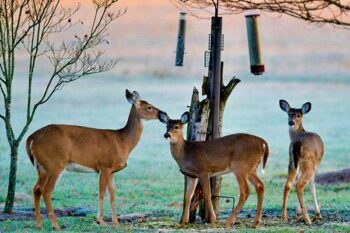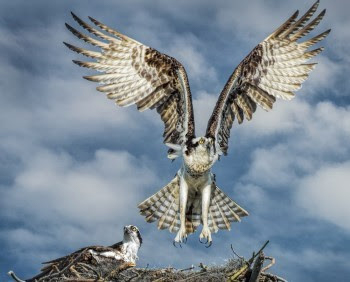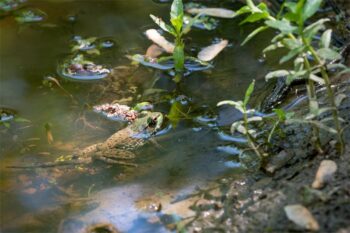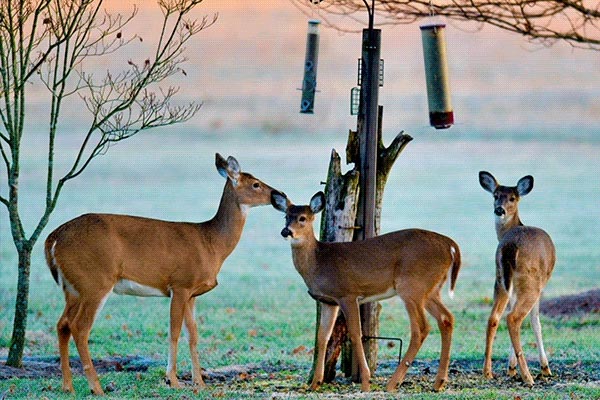Keeping deer away from bird feeders

This spring and summer, we need your help to keep deer from browsing on the birdseed in your feeders and on the ground beneath. Food sources like bird feeders congregate deer, raising the risk of deer passing diseases to the other deer gathered there.
Baiting and recreational feeding of deer remains illegal throughout the Lower Peninsula and the Core CWD Area in the Upper Peninsula. The ban is in place to lower the risk of spread of chronic wasting disease (CWD) and bovine tuberculosis. Both diseases are spread through saliva and other bodily fluids that can be present at shared feeding sites.
You can help keep deer away from your feeders with these bird feeding tips:
- Use feeders that are difficult for deer to access, like tube or hopper feeders or suet cages.
- Use birdseed that is less attractive to deer, like thistle, suet and hummingbird nectar.
- Only put out the amount of seed that birds will eat in a day. Deer tend to visit feeders in the evening and if they find empty feeders, they will move on.
- Hang your feeders high – 6 feet off the ground or higher – to keep deer from accessing seed.
- Hang your feeders close to the house, as deer may be less likely to approach a dwelling.
- Keep the ground under your feeders clean to prevent deer browsing. Use mess-free seed or rake the area regularly.
- Securely install 4-foot or taller woven-wire fencing around all your feeders to prevent deer from reaching over or through to feed.
- Fence your yard with woven-wire fencing that is at least 10 feet tall to prevent deer from entering.
Taking these steps can help slow the spread of deer disease in Michigan. We appreciate your help.
Questions? Contact us at 517-284-9453 (WILD)
Adopt an osprey nest this summer

An early sign of spring, ospreys are making their return to Michigan. The magnificent fish-hawk with striking brown and white plumage can be seen flying along shallow, fish-filled waters of the Great Lakes region — hovering, then plunging feet-first to snare fish in its talons. Ospreys can be found across the state, but they once faced an uncertain future here.
Osprey were severely affected by use of the pesticide DDT and were listed as a threatened species in Michigan after their population declined precipitously in the 1960s. Fortunately, the sale and use of DDT was banned in 1972, giving ospreys a fighting chance. Thanks to the hard work and dedication of MI Birds partners, the DNR, the Detroit Zoological Society and friends at Huron-Clinton Metroparks, the osprey was successfully reintroduced to southern Michigan and removed from the threatened species list in 2009.
However, it is incredibly important that ospreys continue to be monitored closely statewide to document the health and abundance of their populations. While this species now boasts over 200 known nest locations throughout the state, it is still listed as a Michigan species of special concern.
Volunteer community scientists like you can help us understand how ospreys are rebounding across the state. All ages and experience levels are invited to participate in the Adopt-A-Nest monitoring program, and it’s easy to do. A minimum commitment of three nest visits between May 15 and Aug. 1, lasting at least 15 minutes each, is all it takes to determine 1) if there is a nesting attempt, 2) if birds are actively nesting and 3) if there are any chicks in the nest. You can visit your nest more often if you’d like!
Binoculars are adequate for most observations, but a spotting scope is useful for determining the number of chicks. Most nests are located on cellular towers and are easily viewed from public roads.
Fill out this sign-up form to adopt an osprey nest.
MI Birds is a public outreach and education program created by Audubon Great Lakes and the DNR, aimed at increasing all Michiganders’ engagement in the understanding, care and stewardship of public lands that are important for birds and local communities.
Questions? Contact Emily Osborne at 414-841-5273.
Help monitor reptiles and amphibians this summer

Now that warm temperatures are back, reptiles and amphibians are out and about — if you look around, you might be able to spot them. Perhaps you’ve heard spring peepers or wood frogs calling. Or maybe you’ve seen a garter snake slip through sprouting blades of grass.
If you see any frogs, toads, salamanders, snakes, lizards or turtles while out exploring natural areas, parks, trails or even your neighborhood, please report your observations to the DNR.
Observations provide valuable data on trends, distribution and relative abundance for Michigan’s reptile and amphibian species and inform the conservation efforts outlined in Michigan’s Wildlife Action Plan.
“Reptiles and amphibians benefit from conservation work done by the DNR and partners, but we also need assistance from community scientists to track how their populations are doing,” said Amy Bleisch, DNR wildlife technician. “Your observations help provide that data.”
Keep an eye out for rare species like Blanding’s turtle, eastern box turtle, spotted turtle and wood turtle, as well as the threatened eastern massasauga rattlesnake. Submit your reports at Michigan.gov/EyesInTheField.
“It is especially important we get sighting reports of these rare species to help shape our conservation efforts here in Michigan,” said Bleisch.
Reports of other reptile and amphibian sightings also are appreciated and can be shared at MIHerpAtlas.org. The Michigan Herp Atlas is a community science program administered in partnership with Herpetological Resource and Management to collect observational data on Michigan’s herpetofauna, or “herps.”
In addition to reporting observations, you can support conservation efforts for rare reptiles and amphibians through the Nongame Fish and Wildlife Fund. Learn more about Michigan’s reptiles and amphibians and how you can help at Michigan.gov/Wildlife.
Questions? Contact the DNR Wildlife Division at 517-284-9453.


